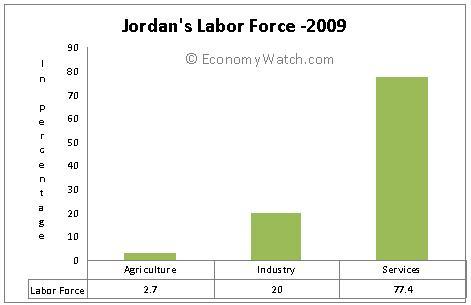Jordan Economic Structure
Please note that we are not authorised to provide any investment advice. The content on this page is for information purposes only.
Jordan was historically a small underdeveloped economy in the Middle East, dependent on foreign assistance. After the accession of King Abdullah II in 1999, the economy has grown considerably in several sectors, registering 8%+ annual growth from 2004 – 2008.
Jordan was historically a small underdeveloped economy in the Middle East, dependent on foreign assistance. After the accession of King Abdullah II in 1999, the economy has grown considerably in several sectors, registering 8%+ annual growth from 2004 – 2008.
The economy wobbled in 2009 due to the global financial depression, leading to a steep fall in the export-oriented industries, but managed to maintain a small amount of growth. Jordan’s reserves of foreign exchange and gold have increased from $8.918 billion in 2008 to $10.29 billion in 2009, but government bonds have been downgraded due to increased risks caused by the wave of arab uprisings, and the King’s sacking of his cabinet and installation of a New Prime Minster.
Jordan has the most open economy in the Arab world, joining more FTAs than any of its compatriots. It is also seen as one of the most stable, recent events not withstanding, is a long term ally of the US, and also has good relations with Israel.
Since 1991, its economic policies have focused on economic stabilization, market liberalization and reducing the size of the government. Jordan has participated in the WTO General Agreement on Trade in services since 2000, and is one of the seven Mediterranean partners that officially opened negotiations on liberalization on services and the right of establishment at the Euro-Mediterranean Trade Ministerial Conference in Marrakech. This liberalization provides Jordan with access to the EU services market, the largest in the world, and provides benefits from EU service technologies, company links and investments.
Table of Contents
GDP – Composition by Sector
The Jordanian economy is overwhelmingly services oriented. 86.2% of the workforce are employed in the services sector, 10.1% in industry and 3.7% in agriculture.
Its main service industries are:
- Construction and civil engineering
- Trade, wholesale and retail
- Transport and logistics
- Hospitality and F&B
- Publishing
- IT and Telecommunications
- Financial Services
- Real Estate
- Education
As it is predominently desert, it does not have a significant agricultural sector.
Jordan Economic Structure: Division by Sectors
The economic structure of Jordon can be divided into the following sectors:
Primary Sector: Agricultural development in Jordan is almost negligible, as is the case with forestry and the fishing industry. However, fruit and vegetable production can still be considered a profitable segment. Jordan’s major produce includes olives, tomatoes, cucumbers, stone fruits, strawberries, citrus fruit and bananas. A very small section of the population is also engaged in dairy, poultry and sheep farming.
Secondary Sector: Jordan’s well developed manufacturing sector makes a significant contribution to the nation’s economic growth. The mining and construction industries have also enabled the nation to emerge as one of the leading economies in the Middle East. Some of the major industrial exports of the country include cement, fertilizers, potash, phosphate and clothes. The United States–Jordan Free Trade Agreement approved in 2001 by the US Senate played a crucial role in expanding Jordan’s manufacturing sector. Around 13 qualifying industrial zones (QIZs) have been set up across the country, subsequent to the agreement. However, it is dependent on foreign trade for the import of raw materials.
Tertiary Sector: Jordan’s tertiary sector mainly comprises banking, insurance, real estate, information technology and tourism. The country’s banking sector, although small, operates on international standards. The sector not only escaped the brunt of the global financial crisis of 2009 due to its conservative policies, but also posted profit during that time. Tourism was once of the biggest foreign exchange earners for Jordan. However, regional insatiability has distracted tourists from visiting the country due to security factors. However, there are signs of improvement. The World Travel and Tourism Council (WTTC) expects the real GDP of the travel and tourism economy of Jordan to rise 4.9% annually from 2010 to 2019.
Jordan’s Labor Force – Occupation by Sector
The labor force currently consists of an estimated 1.667 million workers.
Of those, 77.4% are occupied in the services sector, 20% in the industrial sector, and 2% in agriculture.
Unemployment currently stands at 13%, down from the 13.% figure in 2009 and the 14% – 15% that was common in the previous decade.
This figure is expected to improve slightly to the 12% – 12.%, but with its high birthrate and young population, of which up to 57% are Palestinian, this is still a poor country; 14.2% are estimated to live below the poverty line.





